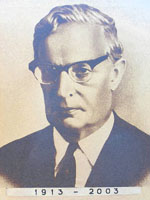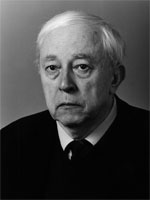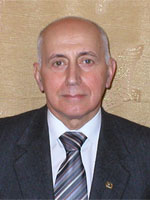The history of our Institute begins from the Institute of Mechanics
of the USSR Academy of Sciences that was organized in May 1939 under the
Department of Engineering Sciences of the Academy. In different years
the Institute was directed by eminent Soviet scientists, a full
member (academician) of the USSR Academy of Sciences Boris Grigorievich
Galerkin, a corresponding member of the USSR Academy of Sciences
Nikolai Gurievich Chetaev, a corresponding member of the USSR Academy
of Sciences Aleksei Antonovich Il'yushin, and Professor
Aleksandr Aleksandrovich Nikol'sky.
The Institute of Mechanics of the USSR Academy of Sciences had Department of Elasticity and Plasticity, Department of Gas Dynamics, Strength Laboratory, Department of Aerodynamics, Department of Hydrodynamics and Filtration, Department of Wave Dynamics, Department of the Shell Theory, Department of Analytical Mechanics, Department of Dynamic Strength, Department of Cavitation and Water Ballistics, and Department of Thermohydrodynamics. The Institute has played an important role in the development of mechanics in the USSR.
However, in the middle 60's of the 20th century, mechanics was called up to solve challenging fundamental problems that were highly important for the development of the entire exact natural science and engineering. Most of these problems were on the border of mechanics with physics, chemistry, and biology.
The Institute for Problems in Mechanics of the USSR Academy of Sciences was initiated to be a great scientific center for studies in the fields of mechanics that were highly essential for science and technologies but, nevertheless, had been developed insufficiently by scientists in mechanics at research institutions of industrial branches or at higher educational establishments. The Institute should become a center that would consolidate scientists in the fields of mechanics from all over the USSR and keep creative contacts with main institutions and research teams dealing with studies in the area of mechanics.
The Institute for Problems in Mechanics of the USSR Academy of Sciences was
organized on January 8, 1965 under the Resolution of the
Presidium of the USSR Academy of Sciences No. 385 of December 04, 1964
to provide investigations in new fields of mechanics. The Resolution was signed
by the President of the USSR Academy of Sciences Academician
Mstislav Vsevolodovich Keldysh.
The organizer and the first director of the Institute was an outstanding
scientist of our time in the field of mechanics Academician
Aleksandr Yulievich Ishlinsky. He headed the Institute till 1990 and
then was the Honorable Director of the Institute until his death. Under his
management, the Institute had become the greatest scientific center of our
country in the field of mechanics.
The Institute for Problems in Mechanics dealt with fundamental investigations in new fields of mechanics using recent achievements of related sciences, physics, mathematics, and chemistry.
Main studies covered physical gas dynamics (mechanics of combustion,
explosion, shock waves, and plasma, as well as issues related to the mechanical
effect of laser radiation), mechanics of polymers (investigation of the
strength of polymers taking into account their physical structure and
transformations), chemical mechanics (hydrodynamics of suspended layers and
other multi-phase systems, hydrodynamics of reacting systems, and mechanics of
abnormal fluids), dynamics of inelastic media (dynamics of heterogeneous
systems, including soils, subject to high-rate deformations), and control of
mechanical motion (optimal stabilization and correction of motion,
pursuit-evasion problems for controlled systems).
The Resolution of the Presidium of the USSR Academy of Sciences on the
organization of the Institute noted that the Institute for Problems in
Mechanics of the USSR Academy of Sciences would be placed in the building of
the Institute of Mechanics of the USSR Academy of Sciences on Leningradskii
Avenue. However, the same Resolution commissioned K.N. Chernopyatov, a
representative of the Presidium of the USSR Academy of Sciences, to write
a proposal for construction of a new building in Moscow.
This building was constructed in the South-West of Moscow. The Institute
moved to the new building in 1976 - 1977. The construction of the building was
supervised by Mikhail Ivanovich Yakushin, a well-known scientific
experimenter and a good manager.
Since the time of its organization, the structure and scientific priorities of the Institute have been updated. These changes were due to the development and appearance of new fields in mechanics, as well as due to the necessity to solve new practical problems.
In 1990, Academician D.M. Klimov became the Director of the Institute. For 15 years on this post, he was keeping the traditions that had been laid by A.Yu. Ishlinsky.
Recently, the latest election of the Director of the Institute was held (2004), and some changes in the scientific structure of the Institute were performed.
At the present time, there are 19 scientific laboratories at the Institute:
- Laboratory of Mechanics of Systems (Head of Laboratory: Yu.K. Zhbanov)
- Laboratory of Mechanics of Controlled Systems (Head of Laboratory: A.A. Melikyan)
- Laboratory of Robotics and Mechatronics (Head of Laboratory: N.N. Bolotnik)
- Laboratory of Fluid Mechanics (Head of Laboratory: Yu.D. Chashechkin)
- Laboratory of Mathematical and Physical Modeling in Hydrodynamics (Head of Laboratory: V.I. Polezhaev)
- Laboratory of Smart Fluid Mechanics (Head of Laboratory: A.N. Rozhkov)
- Physical Gasdynamics Laboratory (Head of Laboratory: S.V. Chalov)
- Thermogasdynamics and Combustion Laboratory (Head of Laboratory: V.M. Gremyachkin)
- Radiative Gasdynamics Laboratory (Head of Laboratory: S.T. Surzhikov)
- Laboratory for Mechanics of Laser Discharge (Head of Laboratory: N.G. Solov'ev)
- Laboratory for Interaction of Plasma and Radiation with Materials (Head of Laboratory: A.F. Kolesnikov)
- Laboratory of Modeling in Solid Mechanics (Head of Laboratory: A.V. Manzhirov)
- Laboratory of Mechanics of Strength and Fracture of Materials and Structures (Head of Laboratory: R.V. Goldstein)
- Laboratory of Mechanics and Optimization of Structures (Head of Laboratory: N.V. Banichuk)
- Wave Dynamics Laboratory (Head of Laboratory: I.V. Simonov)
- Tribology Laboratory (Head of Laboratory: I.G. Goryacheva)
- Laboratory of Geomechanics (Head of Laboratory: Yu.F. Kovalenko)
- Laboratory for the Mechanics of Natural Hazards (Head of Laboratory: S.Yu. Dobrokhotov)
- Laboratory of Computer Engineering (Head of Laboratory: N.E. Isikov)
The Institute performs basic research in a wide spectrum of issues of mechanics and related sciences. The investigations are conducted under Resolutions of the Russian Academy of Sciences, within the framework of Federal and Special Programs, and under contracts with various organizations. Since the time of organization of the Russian Foundation for Basic Research (RFBR), employees of the Institute have won 20 - 30 grants for initiative projects annually. The Institute collaborates with related institutes of the Russian Academy of Sciences located in Moscow (the A.A. Blagonravov Institute of Machines Science of RAS, the V.A. Trapeznikov Institute of Control Problems, The Institute of Applied Mathematics, the V.A. Steklov Mathematical Institute), as well as with institutes of the Siberian, Urals, and Far East Branches of the Russian Academy of Sciences.
The Institute's investigations are important for applications in aerodynamics, geophysics, space exploration, and instrument-making industry. The Institute has close contacts with leading research institutes of industrial branches and universities. Among these institutes are the Institute of Mechanics of the Moscow State University, Central Aero- and Hydrodynamical Institute (TsAGI), A.I. Krylov Central Research Institute, Central Research Institute of Machine Building (TsNIIMash), Moscow Institute of Heating Engineering, S.P. Korolev Rocket and Space Corporation , Central Research Institute , the S.V. Ilyushin Aviation Complex, the All-Russia Scientific Research Institute of Railway Transportation, the All-Russia Scientific Research Institute of Gas (VNIIGAZ), LUKOIL Company, and many others.
None of the institutes of the Academy of Sciences can work successfully
without talented young scientists and contacts with universities. The history
of the Institute is closely related to such universities as Moscow Institute
of Physics and Technology, two chairs of which ("Mechanics and Control
Processes" and "Physical and Chemical Mechanics") have been based at the
Institute for more than 30 years, the M.V. Lomonosov Moscow State University
(Department of Mechanics and Mathematics, Department of Physics, and
Department of Computational Mathematics and Cybernetics), the N.E. Bauman
Moscow State Technical University (Department of Special Machine Building,
Department of Power Mechanical Engineering, and Department of Fundamental
Sciences), Moscow Engineering Physics Institute, Moscow Aviation Institute
(MAI), Moscow Energy Institute (MEI), and Moscow State Aviation Technological
University. Most employees of the Institute graduated from these universities.
In 2005, four Educational Scientific Centers in the field of mechanics and scientific foundation of engineering were organized at the Institute:
- Institute for Problems in Mechanics / Moscow Institute of Physics and Technology
- Institute for Problems in Mechanics / Moscow State Aviation Technological University
- Institute for Problems in Mechanics / the Bauman Moscow State Technical University
- Institute for Problems in Mechanics / Physical Department of the Lomonosov Moscow State University
The Institute for Problems in Mechanics has Post Graduate Courses (Ph.D. Courses) for training young scientists. Enrollment to the post graduate courses was not interrupted even in the most adverse years of perestroika. Currently, there are 22 Ph.D. students that are trained at the Institute. Recently a Doctoral Study was organized at the Institute as an additional measure for attracting young scientists who have a Ph.D. degree and want to work for science.
There is a Dissertation Council at the Institute. Academician A.Yu. Ishlinsky was the chairman of this Council until his death. After A.Yu. Ishlinsky's death, the Council has been headed by Academician Klimov. About 10 sessions of the Council occur each year. On these sessions, Ph.D. and D.Sc. dissertations are successfully defended by scientists from both the Institute for Problems in Mechanics and other organizations.
To obtain achievements in science, it is necessary to have modern technical facilities. Much attention has been given to the creation of powerful engineering support for experiments since the organization of the Institute. The engineering basis for experiments was created and is being maintained at the Institute. The Institute has about 70 experimental complexes, the most powerful of which are:
- high-voltage plasma generators of power up to 1000kW;
- technological lasers of power from 1 to 10kW;
- hydrophysical complex of equipment for studying turbulence, jets, traces, vortices, internal waves in heterogeneous media, and other phenomena;
- installation for tri-axial compression of solids and rocks;
- robotic wall-climbing research complex;
- installations for visualizing micro-jet processes and studying rheological properties of fluids;
- installation for studying flows of viscoplastic media in channels and cavities with vibrating walls.
Four experimental installations - laser installation "Lantan",
plasma generator "Plazmotron 1000", robotic complex "Robot B",
and "Hydrophysical complex" had a financial support from the Ministry of
Science and Technologies of the Russian Federation as unique equipment.
The Institute has always been equipped with newest computers.
The scientific results of the Institute are well known abroad. Research projects of the Institute have been financed by various international organizations, including European Space Agency, International Space Station Project, INTAS (International Association for the promotion of cooperation with new Independent States from the former Soviet Union), CRDF (U.S. Civilian Research and Development Foundation), and Humboldt Foundation. Among the Institute's employees, there are winners of international prizes and members of foreign Academies.
The results of the Institute's researchers are published in leading journals in Russia and abroad. About 300 monographs have been published for the entire history of the Institute. These monographs are exhibited in the Institute's foyer.
Scientific achievements of the Institute's employees have always been highly accessed. This is indicated by awards and prizes that our employees won in different years. First of all, these are Lenin Prizes and State Prizes in the field of science and technology, as well as Prizes of the Russian Academy of Sciences and international awards. The Institute has always provided possibilities for creative growth of young scientists. This is proved by the list of awards and prizes. These are Lenin Komsomol Prize and State Prize for Young Scientists.
Nowadays, the Institute has 372 employees, including 4 full members of the Russian Academy of Sciences (two of them are part-time employees), 3 corresponding members of the Russian Academy of Sciences, 57 have a D.Sc. degree, and 87 have a Ph.D. degree.
Among the Institute's scientists, there are 3 Lenin Prize winners, and 18 State Prize winners.
Directors of the Institute for Problems in Mechanics
 Academician Aleksandr Yulievich Ishlinsky
Academician Aleksandr Yulievich Ishlinsky
Director of the Institute from 1965 to 1990
 Academician Dmitry Mikhailovich Klimov
Academician Dmitry Mikhailovich Klimov
Director of the Institute from 1990 to 2004
 Academician Felix Leonidovich Chernousko
Academician Felix Leonidovich Chernousko
Director of the Institute since 2004

